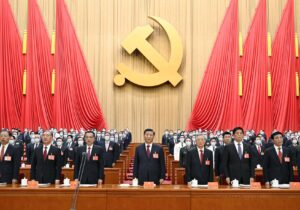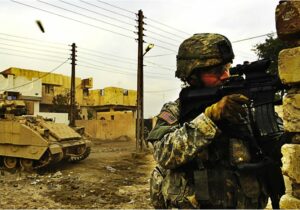Last week I provided remarks to the House Permanent Intelligence Committee. I was asked to provide the Committee with my assessment of what to prioritize in the next Congress. Perhaps counter-intuitively, one recommendation was to de-classify more of the malign activities America’s fiercest enemies are engaged in across the world. With more knowledge of Russia and the CCP’s machinations, the seemingly fractious and divided American people will unify, resolved to win the new Cold War.
The rest of my remarks are summarized below, and it will come as no surprise to Providence readers that I urged the Committee to orient the IC to focus on what it can do to enable the United States to more credible deter a major war that could lead to a nuclear war. Three points of emphasis:
1. U.S. efforts to decrease the role nuclear weapons play in its national defense strategy, to pursue disarmament objectives, increase the role of arms control and risk reduction, and to impose some unilateral restrictions, have increased the role nuclear weapons play in the strategies of China and Russia
2. In 2020, the United States, with China and Russia, agreed to that, “A nuclear war cannot be won and must never be fought.” But China’s and Russia’s nuclear investments, the increased size and variety of their forces, nuclear infrastructure, and Russia’s nuclear saber-rattling demonstrate that they may believe such a war could be fought and won.
3. Deterring adversaries from going down a path that could lead to nuclear employment must be the top priority for our nation. Rather than being one of several competing priorities, it must be the priority. Our political leaders must therefore ensure the IC is giving urgently due attention to deterrence so that decision makers are given the clearest and most accurate understanding of our top adversaries.
Accordingly, I’ll offer three areas of focus for the IC:
- Chinese and Russian decision making surrounding nuclear weapons planning, acquisitions, and possible use.
- Cooperation between China and Russia in key areas of research development and in hybrid activity.
- The degree to which Chinese and Russian nationals continue to operate inside U.S. research labs to the benefit of U.S. adversaries.
The United States must devote significant IC focus on China’s and Russia’s decision-making.
China rejects transparency measures and its security decisions, especially around nuclear weapons, are opaque. It is imperative the IC work to better understand the decisions inside the PRC, and the motives that drive its investments in and the posture of its nuclear forces. The United States risks underestimating the capabilities of its adversaries and, if assumptions are not interrogated, utterly missing the intent of their nuclear weapons strategy.
To give a snapshot of how fast the PRC is moving in its nuclear expansion, observe two public IC assessments, only 3 years apart.
“Over the next decade, China’s nuclear warhead stockpile—currently estimated to be in the low 200s—is projected to at least double in size as China expands and modernizes its nuclear forces.” – 2020 DoD Report.[1]
And then this one: “DoD estimates that the PRC possessed more than 500 operational nuclear warheads as of May 2023—on track to exceed previous projections. —2023 DoD Report.[2]
Russia is also refusing stability talks with the United States and is no longer complying with the last nuclear arms control treaty, the 2009 New START Treaty.[3] Understanding Russian leadership’s thinking about its nuclear strategy in service of its expansionist aims is imperative. Pursuant to this end, the IC should also reassess the premises of its analytical framework by reconsidering the motives behind the nuclear acquisition of the PRC and Russia.
The U.S. Strategic Posture Commission, on which I and eleven other professionals served, concluded “that America’s defense strategy and strategic posture must change in order to properly defend its vital interests and improve strategic stability with China and Russia.” [4] One common criticism is that our report will precipitate an “arms race.” This is a deeply unhelpful label that confuses more than clarifies.
We know from the Cold War that, despite the insistence of some, U.S. efforts to improve the credibility of its strategic deterrent is not the primary motivator for adversaries to invest in and deploy various nuclear weapons. In reality, adversaries make investment decisions based on their strategic culture and perceptions of what they require for their military and national objectives.[5]
China and Russia are collaborating in military development and engaging in increasingly aggressive hybrid warfare.
China and Russia are collaborating in key sectors with direct military applications. Russian and Chinese officials offer public support for one another’s aggression and erroneous territorial claims. And Putin has said he hopes to expand their cooperation.[6]
A DoD public report covering military developments involving the PRC until the end of 2022 concluded, “The PRC probably will use its new fast breeder reactors and reprocessing facilities to produce plutonium for its nuclear weapons program, despite publicly maintaining these technologies are intended for peaceful purposes.” [7]
In March 2023, DoD publicly confirmed media reporting that Russian nuclear energy company Rosatom is supplying China with enriched uranium. John F. Plumb, assistant secretary of defense for space policy said “It’s very troubling to see Russia and China cooperating on this,” [8]
He went on, “They may have talking points around it, but there’s no getting around the fact that breeder reactors are plutonium, and plutonium is for weapons. So I think the [Defense] Department is concerned. And of course, it matches our concerns about China’s increased expansion of its nuclear forces as well, because you need more plutonium for more weapons.” [9]
Russia’s full-scale invasion of Ukraine and China’s materiel, diplomatic, and economic support continues to receive the most public attention and understandably so. Even so, Russia and China are engaged in a variety of other acts of aggression, from cutting gas pipelines on the seabed[10] to using sonar pulses[11] and water cannons against U.S. allies operating lawfully and peacefully in international waters. The PRC and Russia are choosing to behave confrontationally and dangerously.
Pursuant to Americans becoming better informed about kind of hybrid warfare China and Russia are engaged in, the Committee might encourage the IC to declassify such information. If America does not meet such gray zone warfare with a proportionate response, Russia and China will only engage in more and riskier confrontations until they are faced with serious resistance.
China’s Exploitation of the U.S. Commitment to Science and Technology Advances
My last point will be brief. Our national laboratories and nuclear enterprise must be secure and utterly free of exploitation. Threats to our national laboratories and across the nuclear enterprise can come from external adversaries or from “insiders,” including employees or “visitors with trusted access.” [12] According to one prominent study, “Between 1987 and 2021, at least 162 scientists who had worked at Los Alamos [National Laboratory] returned to the PRC to support a variety of domestic research and development (R&D) programs.” [13]
And, according to a May 2023 Government Accountability Office report, which was mandated by the 2022 National Defense Authorization Act, the Department of Energy has not yet implemented its recommendations to protect against the “insider threat.” [14]
In conclusion, the United States has not thought seriously major power confrontation and conflict in decades. Therefore, we must rebuild and reorient the IC and relearn the lessons from the first Cold War—and with urgency.
[1] “Military and Security Developments Involving the People’s Republic of China Annual Report to Congress.” U.S. Department of Defense, 2020. https://media.defense.gov/2020/Sep/01/2002488689/-1/-1/1/2020-DOD-CHINA-MILITARY-POWER-REPORT-FINAL.PDF.
[2] “Military and Security Developments Involving the People’s Republic of China Annual Report to Congress.” U.S. Department of Defense, 2023https://media.defense.gov/2023/Oct/19/2003323409/-1/-1/1/2023-MILITARY-AND-SECURITY-DEVELOPMENTS-INVOLVING-THE-PEOPLES-REPUBLIC-OF-CHINA.PDF.
[3] “Russian Noncompliance With and Invalid Suspension of the New START Treaty,” US State Department, June 1, 2023, https://www.state.gov/russian-noncompliance-with-and-invalid-suspension-of-the-new-start-treaty/.
[4] “America’s Strategic Posture: The Final Report of the Congressional Commission on the Strategic Posture of the United States.” The Congressional Commission on the Strategic Posture of the United States, October 2023. https://www.ida.org/-/media/feature/publications/a/am/americas-strategic-posture/strategic-posture-commission-report.ashx.
[5] For further information on the myth of an arms race, please see Kyle Balzer, Matthew Costlow, and Robert Peters, “A Misleading Metaphor: The Nuclear ‘Arms Race,’” War on the Rocks, November 20, 2023, https://warontherocks.com/2023/11/a-misleading-metaphor-the-nuclear-arms-race/.
[6] “Putin calls for closer Russia-China cooperation on military satellites and prospective weapons,” AP News, November 8, 2023, https://apnews.com/article/russia-china-military-cooperation-d4fedabf86d88e2cc0074159294026f9.
[7] “Military and Security Developments Involving the People’s Republic of China Annual Report to Congress.” U.S. Department of Defense.
[8] David Vergun, “Russia Reportedly Supplying Enriched Uranium to China,” DOD News, March 8, 2023, https://www.defense.gov/News/News-Stories/Article/Article/3323381/russia-reportedly-supplying-enriched-uranium-to-china/.
[9] Ibid.
[10] Claudia Chiappa and Pierre Emmanuel Ngendakumana, “ ‘Everything indicates’ Chinese ship damaged Baltic pipeline on purpose, Finland says,” Politico, December 1, 2023, https://www.politico.eu/article/balticconnector-damage-likely-to-be-intentional-finnish-minister-says-china-estonia/.
[11] Andrew Greene, “Australia’s navy chief confronts Chinese counterpart over ‘unsafe’ sonar attack against HMAS Toowoomba,” MSN, February 5, 2024, https://www.msn.com/en-au/news/other/australia-s-navy-chief-confronts-chinese-counterpart-over-unsafe-sonar-attack-against-hmas-toowoomba/ar-AA1o3a7V?ocid=BingNewsSerp.
[12] Government Accountability Office. “Nuclear Security: DOE Should Take Actions to Fully Implement Insider Threat Program.” GAO Reports and Testimonies. Published May 23, 2023. Accessed May 13, 2024. https://www.gao.gov/products/gao-23-105576.
[13] “The Los Alamos Club: How the People’s Republic of China Recruited Leading Scientists from Los Alamos National Laboratory to Advance Its Military Programs.” Strider Technologies, Inc., September 22, 2022, https://content.striderintel.com/wp-content/uploads/2022/09/Strider-Los-Alamos-Report.pdf.
[14] GAO, “Nuclear Security.”






